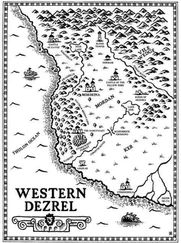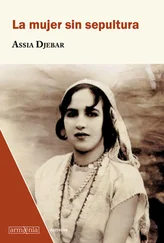Thus, even if the funerary monument has regained its hybrid — half Greek, half oriental — elegance, some mystery still seems to hang over Dougga, over the lapidary writing, the words in stone that were desecrated and carried off but also those words, victims of erosion, that have almost entirely vanished.
THE WRITING AT DOUGGA began to raise interesting questions starting with the scholar Gésénius, who outlines several conjectures after learning about it through the copy published in 1835 by Lord Temple. In Paris, de Saulcy does detailed research, then Honegger visits the site, but it is Célestin Judas, especially, who, during the years from 1846 through the 1860s, clarifies the meaning of the seven lines in Libyan and succeeds in listing the twenty-three characters of the alphabet.
A work begun at the end of the preceding century had just appeared. The author, Venture de Paradis, had compiled a French-Berber dictionary that was published, with a preface by Champollion, in 1838. Célestin Judas will base his work on numerous remarks made by Venture de Paradis, who had persistently questioned the Kabylians of Algeria about the structure of their dialect.
Throughout the nineteenth century all the questions asked about the stele of Dougga focused on some vanished alphabet, some lost language — one as ancient as the elegant figures of African princes who paid visits to the pharaohs and were melancholically rendered on Egyptian frescos.
Paleographers, following the example of Champollian, felt they were penetrating into a cavern of images and scripts that were indeed exciting but from the past.
Now comes a trickle of doubt: What if this “old African,” which in North Africa the indigenous people themselves consider to be merely an oral dialect, what if this “barbarous” speech, before being accepted as “Berber,” used to be written? What if it was a written language, was the same as Libyan, whose shadows loom throughout the seven centuries of Carthaginian power, yes, what if this archaic alphabet had preceded the Phoenician culture and survived long after it?
Then suppose this strange writing came alive, was a voice in the present, was spoken out loud, was sung. Suppose this so-called dialect of men who spoke by turn Punic with Carthage, Latin with the Romans and the romanized until Augustine’s time, and Greek, then Arab for thirteen centuries, continued, generation after generation, kept alive for endogamic use (mainly with their mothers, their wives, and their daughters). Suppose this speech, this language — the one in which Jugurtha expressed his insurmountable energy as he fought and died, the very one Masinissa spoke throughout his sixty-year reign — went back even farther! Suppose, even longer ago, the Barbarians/Berbers, the great pharaohs’ guests and sometimes their friends or rivals, mentioned by Herodotus of Halicarnassus — suppose those ancestors, who apparently sometimes surrendered to peoples from the east or north and sometimes rose up, struggling until they were put down — yes, suppose these first men and these first women had written this alphabet on skins, shards, stone, on their horses’ and camels’ flanks — same signs, same symbols — which then became indecipherable until the mid-nineteenth century, in short until a stele with seven lines on it was carried to the British Museum, leaving in its wake a field of broken statues and felled columns.
And leaving scholars in their studies to seek and study and listen and suppose … always with the thought that they are on a quest for some lost meaning — underground echoes.
And yet the writing was alive. Its sonority, its music, its rhythms still reeled on around them, around the travelers and their followers going back and forth between Dougga and Cirta. It traveled into conquered Constantine and onto the Kabylian mountains, still rebellious fifteen years after the fall of Constantine, and then, beyond the dunes and sands of the Sahara, it went all the way to the heart of the desert itself! For there, from the Fezzan to Mauritania, among the nomads who thought they had forgotten the Numidians, Libyan letters from earlier times have stealthily slipped in ever since. Perhaps they came in the days of the Garamantes — who gave up their horses for the newly introduced camels, who let the herds of ostriches disappear from their lands until only their silhouettes, in a dancing, animated crowd, remained, engraved on the walls of caves a thousand years old.
The Libyan letters, however they did it, escaped all together, curled up as far away as possible in the reddish dunes as if propelled by some immobile god. They went off to hide in the palms of noble women — the queens, the wives, the lovers of the Veiled Men.
The writing of the sun, fertile secret of the past!
This lost writing was resurrected in various stages over the course of several decades and once more with an Anglo-French rivalry as their basis.
In 1822, after traveling from Alexandria to the Tripolitan regency, a man named Scholz brings various unfamiliar characters to the attention of the public. He believes some of these signs found on old, ancient monuments as well as on Arab buildings, to have been carved several centuries earlier while others, in contrast, seem of rather recent origin.
In 1827 another traveler — his name is Pacho, and he is from Cyrenaica — notices other odd signs on buildings and rocks; he also sees the same signs written by nomads on their camels’ flanks. He reaches the rapid conclusion that this is not an alphabet of some lost language but utilitarian signs the shepherds use.
Before Pacho, however, during the years 1822 and 1823, Walter Oudney, a medical doctor returning from an expedition, brought back nineteen characters that he had seen traced on a Roman monument at Germa and then on rocks in the deserts between Tripoli and the Fezzan, places frequented by the Tuaregs. He determines that some of the signs are several centuries old and others were made more recently. Oudney, publishing his account, is quite clear: In Germa the inhabitants are unable to read most of the inscriptions. But, pushing beyond their borders, the traveler meets up with the Tuaregs and learns to understand their writing: “We discovered for the first time that the characters traced on the rocks were Tuareg!”
This English account is available in Paris in 1836, where first de Saulcy and then Célestin Judas learn about it. The mystery begins to split open: They finally say to themselves, what if this writing that is so ancient were still being written?
So, at the same moment, in Paris, Ali Effendi ben Hamdane Khodja is telling de Saulcy about his stay with the Kabylians when he was traveling with his father. De Saulcy translates this account into French. To thank him, Ali Effendi agrees to lend one or two letters that he still has from the correspondence between his father and the bey Ahmed.
The Parisian scholar is confronted by the following puzzle: The main text is in Arab; but, running along the sides, the bey Ahmed has written several lines of a secret writing: just simple code, de Saulcy thinks. Plagued by curiosity, however, he gets the idea overnight to compare these signs with the ones copied by Dr. Oudney in Cyrenaica. Then, to decipher the first line, de Saulcy remembers that any letter written between Muslims begins with the sacred formula: “In the name of God the Merciful, the Forgiving! …”
Suddenly the Frenchman understands: and what if the bey Ahmed, who could obviously speak Chaoui Berber, has learned — thanks to Saharan nomads passing through Constantine — this mysterious writing and used it as a code, thinking that this alphabet, now so rare, is the only thing that can ward off the danger of interception?
In short, de Saulcy concludes in amazement, contrary to what Venture de Paradis believed when he made a point of learning Berber but thought it normal to write it in Arabic characters, in short, what if Berber had always been a written language? Was still written? Since the dawn of time?
Читать дальше












